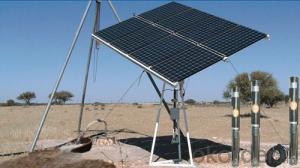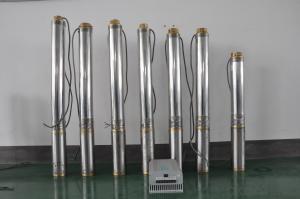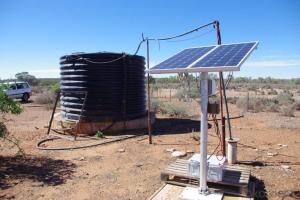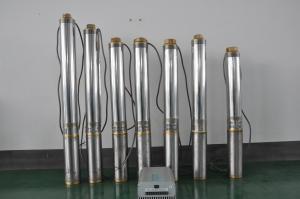Solar Powered Water Pump Solar Water Heater Panels
- Loading Port:
- Shanghai
- Payment Terms:
- TT OR LC
- Min Order Qty:
- 1 set
- Supply Capability:
- 1000 set/month
OKorder Service Pledge
OKorder Financial Service
You Might Also Like
Solar Powered Water Pump Solar Water Heater Panels
DC solar water pumping system consists of the motor, pump, controller, solar array and some other accessories, such as water level sensor, float switch, etc. Considered that storing water is more efficient than storing electricity, the system is designed to directly drive the pump without battery which can reduce the construction and operating cost and routine maintenance effectively.The PV array consists of multiple solar panels connected in series/parallel, which can supply the whole system as power source by converting the absorbed solar radiation energy to the electrical energy. The pump driven by a brushless DC permanent magnet motor draws water from deep-well or river. The pumped water is then fed into reservoir or water tank, or connected to the irrigation system or fountain system directly.
Advanced Technology
Applications Innovation
The efficiency of DC brushless permanent magnet motor has been increased up to 25% in comparison with traditional asynchronous motor.
Technology Innovation
Stator and rotor are sealed by environment friendly casting resin.Motor insulation resistance can be hold higher than 300MΩfor more than 10 years, which consumedly increased the security and reliability of the submersible motor.
Structure Innovation
Casting resign technology processed stator and rotor as well as the water lubricated bearing make the submersible pump environment friendly.
Feature
High Efficiency & High Reliability
DC Brushless Permanent Magnet Motor
Minimum Maintenance, long Service Life
Environment Friendly Materials, Lubricated Without Oil
Application
Village or Family Water Supply
Animal Drinking Water & Livestock Watering
Garden/Courtyard Irrigation
Swimming Pool
Water Supply for Bivouac or Camping Car
Water Supply for Remote Area
Automatic Control
Operate Automatically, No Need Watching
Maximum Power Point Tracking (MPPT)
Dry-run Protection
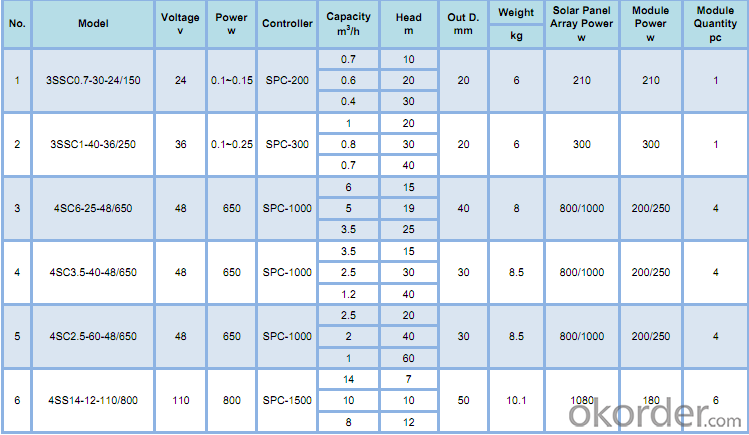
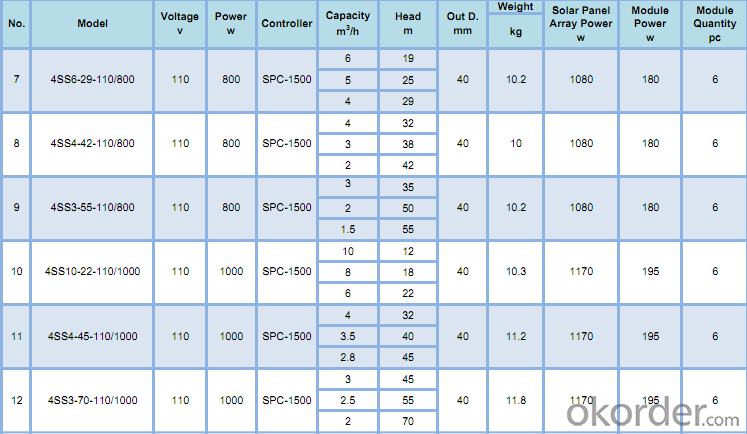
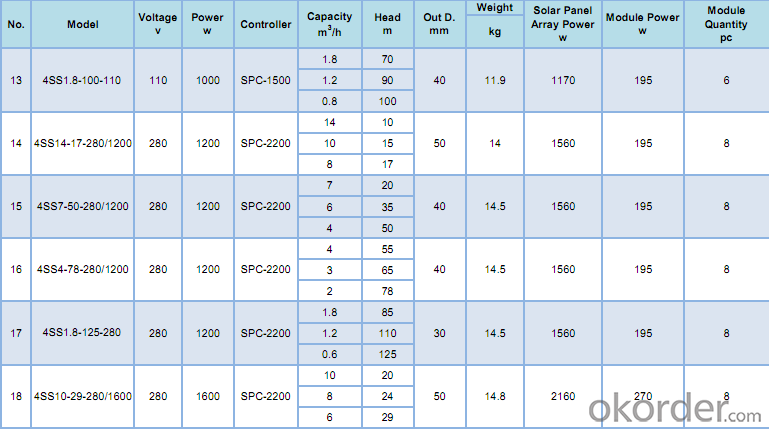
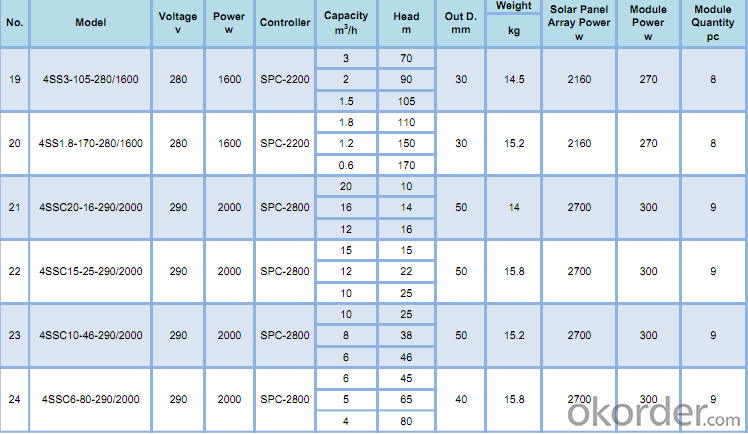

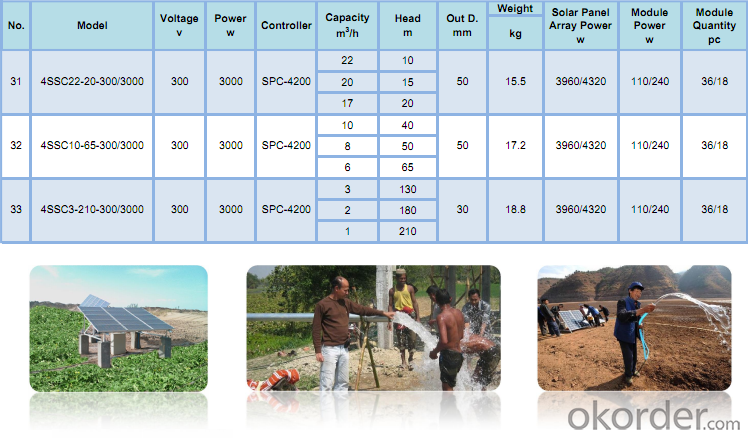
- Q:How do I properly size the solar array for a solar pump system?
- To properly size a solar array for a solar pump system, there are several factors to consider. Firstly, you need to determine the total power consumption of your pump system. This includes the power required to run the pump itself, as well as any additional accessories or equipment such as controllers or sensors. It is important to consider the peak power demand of the pump system to ensure that your solar array can meet the requirements even during periods of high demand. Next, you should assess the solar resource available at the installation site. This includes factors such as the average daily sunlight hours, the solar irradiance, and any shading or obstructions that may affect the solar panels. This information can be obtained from solar maps or local meteorological data. Once you have determined the power consumption and solar resource, you can calculate the size of the solar array needed. The basic formula is: Solar Array Size (in watts) = Power Consumption (in watts) / Solar Resource (in watts per square meter) For example, if your pump system consumes 1000 watts and the solar resource at your location is 200 watts per square meter, you would need a solar array of 5 square meters (1000 watts / 200 watts per square meter). It is also important to consider system losses and inefficiencies when sizing the solar array. These losses can be due to factors such as temperature, wiring, and inverter efficiency. To account for these losses, it is recommended to multiply the calculated solar array size by a factor of 1.25 to 1.5. Additionally, you may want to consider the battery storage capacity for your solar pump system. This will ensure that you have sufficient power during periods of low sunlight or at night. The battery capacity should be determined based on the amount of power required during these periods, and it should be sized to provide enough energy storage to meet your specific needs. Overall, properly sizing the solar array for a solar pump system requires careful consideration of the power consumption, solar resource, system losses, and battery storage capacity. It is recommended to consult with a solar professional or installer to ensure accurate calculations and optimal performance for your specific application.
- Q:How does a solar pump handle water with high levels of chlorine or other disinfectants?
- A solar pump does not directly handle or treat water with high levels of chlorine or other disinfectants. The primary function of a solar pump is to draw water from a source, such as a well or a reservoir, and transfer it to a desired location using solar energy. If the water being pumped contains high levels of chlorine or disinfectants, it is advisable to treat the water before it enters the solar pump system to ensure proper functioning and longevity of the equipment.
- Q:How much sunlight is needed to operate a solar pump?
- The amount of sunlight needed to operate a solar pump depends on various factors such as the size and efficiency of the pump, the capacity of the solar panels, and the geographical location. In general, solar pumps require a minimum amount of sunlight to function optimally. The most efficient solar pumps can operate with as little as 2-3 hours of direct sunlight per day. However, this is a minimum requirement, and for better performance, longer exposure to sunlight is recommended. Ideally, solar pumps should receive 5-6 hours or more of full sunlight to generate enough power to meet their pumping requirements. It is important to consider the weather conditions as well. Cloudy or overcast days can significantly reduce the amount of sunlight reaching the solar panels, which may affect the pump's performance. In regions with limited sunlight, it is advisable to install additional solar panels or use a battery backup system to ensure a constant power supply for the pump. It's worth mentioning that solar pumps can also work with indirect or diffused sunlight, although the efficiency may decrease. Therefore, even on partially cloudy days, solar pumps can still operate, albeit with reduced output. To determine the exact sunlight requirements for a specific solar pump, it is recommended to consult the manufacturer's specifications or seek advice from a solar energy professional who can assess the local conditions and provide accurate guidance.
- Q:How do solar pumps handle water with high bacterial or microbial content?
- Solar pumps do not have a direct mechanism to handle water with high bacterial or microbial content. However, solar-powered water pumps can be integrated with additional water treatment systems, such as filters or chlorinators, to address the issue of high bacterial or microbial content in water. These systems can effectively remove or disinfect the bacteria or microbes, ensuring safer water for various applications.
- Q:How does a solar pump handle power outages or blackouts?
- A solar pump does not rely on grid power, so it remains unaffected by power outages or blackouts. It operates independently using solar energy, making it a reliable solution even during times when there is no electricity supply.
- Q:How do I monitor the performance of a solar pump system?
- To monitor the performance of a solar pump system, there are several key steps you can take: 1. Install monitoring equipment: Start by installing a monitoring system that can track and record various parameters of the solar pump system. This may include sensors to measure solar radiation, pump output, battery voltage, water flow rate, and other relevant variables. The monitoring equipment can be connected to a central control unit or a data logger for data collection. 2. Set performance benchmarks: Determine the performance benchmarks or targets for your solar pump system. These benchmarks may include desired water flow rate, battery charge level, or pump efficiency. Having clear benchmarks will help you evaluate whether the system is performing optimally or if there are any issues that need attention. 3. Regularly review data: Check the monitoring data regularly to assess the system's performance. This can be done by analyzing the collected data manually or by using software that can present the data in a more organized and comprehensive manner. Look for any deviations from the benchmarks and identify any patterns or trends in the system's performance. 4. Conduct performance audits: Periodically conduct performance audits to evaluate the overall efficiency and effectiveness of the solar pump system. This can involve observing the system's operation, measuring parameters on-site, and comparing the results with the benchmarks. Performance audits can help identify any inefficiencies, malfunctions, or maintenance needs. 5. Utilize remote monitoring: Consider using remote monitoring capabilities if available. Remote monitoring allows you to access real-time data and receive alerts or notifications if any critical parameters deviate from the desired range. This offers the advantage of proactive monitoring and early detection of potential issues, enabling timely corrective actions. 6. Regular maintenance and servicing: Ensure regular maintenance and servicing of the solar pump system. This includes cleaning of solar panels, checking and tightening connections, inspecting pipes and valves, and testing the overall system functionality. Proper maintenance ensures optimal performance and helps prevent any potential breakdowns or inefficiencies. 7. Seek professional assistance: If you are unsure about monitoring the system yourself, consider consulting with a professional solar installer or a technician specialized in solar pump systems. They can provide guidance on the specific monitoring equipment and procedures needed for your system, as well as offer expert advice on troubleshooting and optimizing its performance. By implementing these steps, you can effectively monitor the performance of your solar pump system, identify any issues or inefficiencies, and take appropriate actions to ensure its optimal operation.
- Q:Can a solar pump be used for irrigation in hilly areas?
- Yes, a solar pump can be used for irrigation in hilly areas. Solar pumps are a great solution for remote and off-grid areas where access to electricity may be limited. In hilly areas, the elevation difference can be utilized to generate the necessary pressure to pump water for irrigation purposes. Solar pumps can efficiently lift water from lower elevations to higher elevations using solar energy, making them suitable for hilly terrains. Additionally, solar pumps are environmentally friendly and cost-effective, as they do not require fuel or electricity from the grid. They can be easily installed and maintained, providing a sustainable and reliable solution for irrigation in hilly areas.
- Q:Can a solar pump be used for water transfer between reservoirs or tanks?
- Yes, a solar pump can be used for water transfer between reservoirs or tanks. Solar pumps are designed to efficiently draw water from one source and transfer it to another, making them ideal for applications such as transferring water between reservoirs or tanks. They utilize solar energy to power the pump, eliminating the need for electricity and making them cost-effective and environmentally friendly solutions for water transfer.
- Q:How does a solar pump handle water with high levels of arsenic or other toxins?
- A solar pump itself does not directly handle water with high levels of arsenic or other toxins. However, solar-powered water treatment systems can be integrated with solar pumps to address this issue. These systems typically incorporate advanced filtration or purification methods, such as reverse osmosis or activated carbon filters, to remove contaminants from the water. Therefore, a solar pump combined with a suitable water treatment system can effectively handle water with high levels of arsenic or other toxins by ensuring safe and clean water supply.
- Q:What are the safety precautions to be taken while operating a solar pump?
- Some safety precautions to be taken while operating a solar pump include: 1. Familiarize yourself with the manufacturer's instructions and guidelines before operating the pump. 2. Ensure the solar panels are installed and positioned correctly, away from any potential shading or obstructions. 3. Regularly inspect the solar panels and wiring for any damage and ensure they are properly grounded. 4. Use appropriate personal protective equipment such as gloves and safety goggles when handling or maintaining the pump. 5. Ensure the pump is properly connected to a grounding system to prevent electrical shock hazards. 6. Regularly inspect the pump and its components for any signs of wear or damage, and promptly repair or replace as necessary. 7. Keep all electrical connections clean and dry to prevent short circuits or electrical hazards. 8. Avoid touching any moving parts of the pump while it is in operation. 9. Ensure the pump is securely mounted or anchored to prevent it from falling or causing any accidents. 10. In case of any malfunction or abnormal operation, immediately shut off the pump and seek professional assistance for troubleshooting and repairs.
1. Manufacturer Overview |
|
|---|---|
| Location | |
| Year Established | |
| Annual Output Value | |
| Main Markets | |
| Company Certifications | |
2. Manufacturer Certificates |
|
|---|---|
| a) Certification Name | |
| Range | |
| Reference | |
| Validity Period | |
3. Manufacturer Capability |
|
|---|---|
| a)Trade Capacity | |
| Nearest Port | |
| Export Percentage | |
| No.of Employees in Trade Department | |
| Language Spoken: | |
| b)Factory Information | |
| Factory Size: | |
| No. of Production Lines | |
| Contract Manufacturing | |
| Product Price Range | |
Send your message to us
Solar Powered Water Pump Solar Water Heater Panels
- Loading Port:
- Shanghai
- Payment Terms:
- TT OR LC
- Min Order Qty:
- 1 set
- Supply Capability:
- 1000 set/month
OKorder Service Pledge
OKorder Financial Service
Similar products
New products
Hot products
Hot Searches
Related keywords
